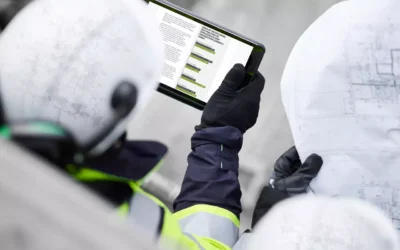When looking at the origins of cost overruns and missed completion dates of capital projects, a solid line can be traced back to productivity levels. While it’s certainly not the only cause, it stands out because so much of it is controllable.
And yet, achieving and maintaining consistent productivity levels has been a challenge for contractors overseeing capital projects because they lack the visibility into their operations that would allow them to adjust in real time. They also lack the ability to control those processes that impact productivity directly.
This is partly because the industry has been slow to embrace technology that enhances efficiency and productivity. Many contractors still rely on manual processes for estimating, scheduling and project management that haven’t changed much in decades.
There are several tried-and-true ways that contractors can regain control over the factors that impact overall productivity levels. While nothing will deliver dramatically improved results overnight, investing time and effort into any or all of these can help contractors achieve higher project performance over time.
Collect and connect data via earned value performance metrics
One of the biggest problems with productivity is that it’s hard to measure without clear visibility into what’s going on with a project. This is a big reason why contractors are turning to earned value management (EVM) metrics.
The concept behind EVM is simple: Track a project’s scope, schedule and cost data in real time as a means of measuring performance against what was planned and budgeted at the start of a given project. For contractors, these metrics help them maintain control over the factors that can sink productivity levels — such as scope changes or internal and external risks, for example.
To do this most effectively requires project management software that can store and process the reams of capital project data in one place.
Starting with relevant source data, ideally from past projects similar in scope, contractors can evaluate the kind of changes and risks that played out and how EVM’s schedule and cost performance metrics responded. This historical lookback serves as a way to predict future performance for the current project. More critically, it becomes the basis for data-informed, accurate forecasting and contingency planning to maintain progress and productivity levels.
Once the project begins, real-time data from the field is gathered and automatically calculated to deliver the EVM metrics that show where things are going according to plan, spot what may be lagging and uncover potential problems early on before they’re more difficult to resolve. While it may sound like an arduous task to continuously monitor these metrics, software with dashboard functionality makes this vastly simpler. When customized with the priority metrics to track and risk notification alerts, it delivers the data visibility and control contractors need to maintain their own productivity while managing that of the project.
Standardize processes with advanced work packaging
One way to gain control over productivity levels is to break down every project into smaller parts. Each task can be managed more effectively, with each step completed in the right order, with the right materials and equipment ready and waiting, for improved workflow and slashed rework costs. This is the basic idea behind advanced work packaging (AWP).
As an early-start, intelligence-based process, AWP is an industry best practice designed to reduce and control cost overruns and delays. But it’s also an effective task management tool for contractors. It identifies and removes productivity-killing constraints — from late-arriving materials to missing equipment to costly downtime — by organizing and tracking the time and location of all labor, materials and equipment resources.
Standardizing how schedules and resources are allocated down to the task level makes it easier for everyone on-site to understand what needs to happen, when and where for a more seamless workflow. These streamlined workflows help keep workers focused on their primary tasks so they can complete work faster and more accurately. Because the work packages are organized based on how construction works, it’s easier for contractors to identify problems early on and apply fixes before they become major issues that could lead to costly delays.
The result is more efficient sequencing of work tasks that are completed on time and within budget, resulting in better control over costs and schedules and measurably improved outcomes. And these are the AWP benefits that will show up in those EVM metrics.
Automate end-to-end construction processes with integrated technology
Having full visibility into all aspects of a project is crucial for making decisions that boost productivity and reduce costs along the way. Without this kind of data access, contractors may find themselves in a position where they’re forced to make decisions based on incomplete information or worse yet, just guesswork.
Yet, many contractors use multiple systems to manage their projects, including spreadsheets, email, file sharing services and cloud storage platforms. They may also have several point solutions they’ve stitched together in an attempt to pass data back and forth among them. Having inconsistent and/or outdated data sources, and lacking real-time visibility into them by the broader project team, makes it hard to pull together the relevant project data necessary to make informed decisions about what needs to happen next.
That manual assembling of data, along with other manual processes for everything from timesheets to commissioning checklists, merely slows down progress and introduces human error that cause productivity levels to dip. To top it off, having fewer people that have time to do those tasks is forcing contractors to find ways to get more done with less.
Adopting a cloud-based integrated platform is helping contractors overcome these challenges.
Such a platform connects the data dots, so contractors gain up-to-the-minute insights into their project’s performance and productivity levels. It automates the many labor-intensive tasks, reducing human errors that later steal time to go back and fix and unleashing back-office staff from time- and effort-wasting manual work. It provides an avenue through which to communicate and collaborate with the project team and stakeholders; everyone is on the same page with the likelihood of miscommunication and missed updates greatly reduced.
The sum of these capabilities is higher productivity which naturally leads to better project outcomes.
Contractors looking to improve productivity should remember that it’s often a matter of incremental improvements. While dramatic results happen for some, for many contractors the gains come about gradually by pursuing a combination of strategies that add up over time. By embracing new technologies and processes, contractors can reduce project costs, improve productivity and minimize the sort of inefficiencies that cause delays.
How can we help you achieve the project performance you want? We’re happy to talk through options — just schedule a consultation with us.
Sign up for our monthly blog newsletter today and stay up to date on the latest industry news.



